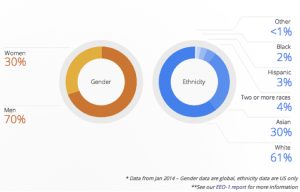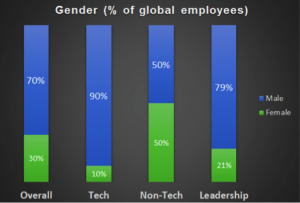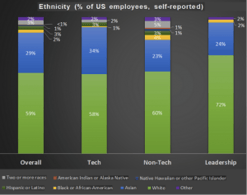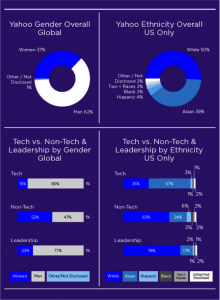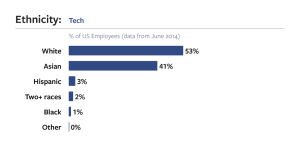In recent years we’ve seen great improvements in female and minority representation in the workplace. However, there are many professions that still struggle to find a healthy balance of varying employee backgrounds. After a recent push, many major social media and online search engine platforms have released their workplace diversity statistics to the public. In this article we will share some of these statistics from four major tech companies with you.
Photo by: MotherJones.com
This online powerhouse may be changing the game when it comes to innovation and making it easier to develop an online workspace, but it falls short in the workforce diversity department. As you can see from this chart displaying Google’s overall workforce, 70% of their employees are male with only 30% female. Black, Hispanic, and multiracial employees only account for 9%. Google’s Senior Vice President of People Operations, Laszlo Bock spoke to the NewsHour in a statement about these stats before a broadcast interview. “We’re not where we want to be when it comes to diversity,” said Bock, “It is hard to address these kinds of challenges if you’re not prepared to discuss them openly, and with the facts. All our diversity efforts, including going public with these numbers, are designed to ensure Google recruits and retain many more women and minorities in the future.”
Photo By: MotherJones.com
Twitter ranks in at 90% male dominated technology positions, leaving the remaining 10% to women, and a similar racial differentiation to Google, leaving nearly 60% of overall and technology positions to Caucasians. With a mere 8% divided between African Americans, Hispanics, and multiracial employees.
Fun Fact: A Recent Pew Research Survey discovered that 22% of active Tweeters are African American, and only 16% of Caucasian Internet users tweet.
Yahoo
Photo by: Yahoo
Yahoo, which is run by a woman, former Google executive Marissa Mayer, divides 85% of all technology positions in the organization to males, while women fill only 15% of positions. Yahoo somewhat breaks the majority Caucasian trend with an ethnicity shift, wherein, 57% of its employees are of Asian heritage with Caucasian employees taking a close second at 35%, and again only 7% divided amongst African Americans, Hispanics, and multiracial employees.
Photo By: Facebook newsroom
Facebook follows the suit of Yahoo in that 85% of the platforms’ tech employees are male. Facebook’s ethnic diversity is also heavily unbalanced. 41% of employees are Asian and 53% are Caucasian, with only 6% to be divided amongst African Americans, Hispanics, and multiracial employees.
Potential causes
The fact is, the problem begins long before females and minorities start applying for jobs. Only 18% of Computer and Information Science undergraduate degrees are female, and statistics show that African Americans only make up about 10% of computer science degrees nationally and Latinos about 8%, therefore a lack of interest in the industry may be a contributing factor
We asked Lyndze Blosser, Interactive Designer here at LaneTerralever, to weigh in. “I think some females feel intimidated entering a predominantly male dominated industry,” she says, “Society doesn’t encourage girls to be intelligent or ‘tinkerers.’ Nowadays there are more video games that are designed for young girls, but they are focused on concepts like fashion and playing house. The stigma is put on the foundation of what it is to be feminine. The negative image that accompanies being a ‘tech girl’ or nerd really hinders women from following their interests.”
Looking to the future
The negative statistics don’t hold true to every organization, and by opening up opportunities for tech exposure to young women and minorities, the future of the industry is looking brighter than ever. In fact, SAP Labs paired up with the University of British Columbia to create a program that they call GIRLsmarts. The goal of these weekend workshops is to get young girls aged 10-13 years old excited about technology professions. After one workshop, participants in the program gain skills in “basic programming, music sound mixing, game design, and the basics of User Interface design.” STEM is another project that provides programs to encourage young ladies to break the stereotype and get their geek on. Creating IL Talent is yet another program created in partnership between the Illinois Department of Commerce and Economic Opportunity (DCEO), YWCA of Metropolitan Chicago, software development company GeneXus USA, and tech hub Blue 1647. This program is free to all students, and all participating organizations are donating their services toward training women and minorities in web and mobile application development. Other companies are paving the way toward equality and a more diverse workplace through conscious hiring efforts, such as eBay’s Women’s Initiative Network and subsequent 42% female workforce.
Interested in tech?
“To be a developer you have to have a lot of confidence in yourself and your abilities because it is a job that will challenge you. If you can’t defend your logic, its tough. Women have a different perspective on developing that is really beneficial; it is great to have different perspectives and new and innovative approaches to back-end coding. Don’t be afraid to put yourself out there and have confidence. To me, code is like a language. People learn languages differently, with different accents. Don’t be too sensitive when someone teaches you something new.” - Lyndze Blosser
“Look at your skill sets, highlight all of your additional languages, and backgrounds. Maximize those skills and use them as a strength.” – Joe Ray, LaneTerralever’s Vice President of Multicultural Strategy
LaneTerralever is always on the lookout for individuals from all backgrounds who can add value to our team. Check out our careers page for current openings.

